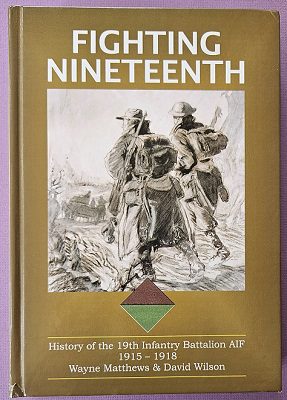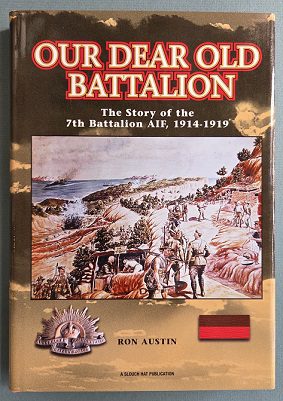Description
Title: Fighting Nineteenth – History of the 19th Battalion AIF 1915 – 1918
Author: Mathews, Wayne and Wilson, David
Condition: Very Good Plus – Some small stains to page block, wear to corners and previous owners name on the front-end page.
Edition: 1st Edition
Publication Date: 2011
ISBN: 9780980777444
Cover: Hard Cover without Dust Jacket – 520 pages
Comments: A comprehensively researched and well written account of the 19th Battalion from it’s formation in 1915, through the bloody battles of Gallipoli to the fighting on the Western Front in France and Belgium.
A must for anyone who had a relative serve in the 19th Battalion, this book includes a comprehensive Nominal Roll of its members and goes into amazing depth about the battles the battalion fought.
The authors had access to private photographs, letters, diaries, the official history and war diaries.
This book includes a research CD with detailed information about the 19th Battalion. It includes a comprehensive Nominal Roll.
The 19th Battalion was raised at Liverpool in New South Wales in March 1915 as part of the 5th Brigade. A large number of the 19th’s original recruits had already served with the Australian Naval and Military Expeditionary Force (AN&MEF) in the operations to capture German New Guinea in 1914. The 19th left Australia in late June, trained in Egypt from late July until mid-August, and on 21 August landed at ANZAC Cove.
At Gallipoli the Battalion participated in the last action of the August Offensive – the attack on Hill 60 – before settling into defensive routine in the trenches. From mid-September, until its withdrawal from the peninsula on the night of 19 December, the 19th Battalion was responsible for the defence of Pope’s Hill.
After further training in Egypt, the 19th Battalion proceeded to France. It took part in its first major offensive around Pozières between late July and the end of August 1916. After a spell in a quieter sector of the front in Belgium, the 2nd Division, which included the 5th Brigade, came south again in October. The 19th Battalion attacked near Flers between 14 and 16 November, in conditions that Charles Bean described as the worst ever encountered by the AIF.
In 1917, the 19th was involved in the follow-up of German forces after their retreat to the Hindenburg Line and was one of four battalions to defeat a counterstroke by a German force, almost five times as strong, at Lagincourt. The Battalion took part in three major battles before the year was out, second Bullecourt (3-4 May) in France, and Menin Road (20-22 September) and Poelcappelle (9-10 October) in Belgium.
The spring of 1918 brought a major German offensive that the 19th Battalion helped to stop. For his actions during the fighting around Hangard Wood on 7 April, Lieutenant Percy Storkey was awarded the Victoria Cross. With this last desperate offensive defeated, the 19th participated in the battles that pushed the German Army ever closer to defeat: Amiens on 8 August, the legendary attack on Mont St Quentin on 31 August, and the forcing of the Beaurevoir Line around Montbrehain on 3 October. Montbrehain was the battalion’s last battle. The casualties of 1918, combined with long-term leave for 1914 enlistees, and dwindling new enlistments had sapped the strength of the AIF. On 10 October 1918 the 19th Battalion was disbanded to reinforce other battalions in the brigade.
About the Authors:

Wayne Matthews and David Wilson
DAVID WILSON
A Sydney resident for 24 years, David Wilson graduated from the Royal Military College Duntroon in 1975 and served in the Royal Australian Infantry Corps. In 1998 he transferred to the Army Reserve where he now works as a part-time project officer. His overseas deployments include Uganda, Cambodia, Thailand (for the tsunami relief operation), and Iraq and Afghanistan as an operations analyst. He also works part-time as a battlefield tour guide at Gallipoli and on the Western Front. His deep interest in military history led him to co-operate in the writing of this book while researching his own WW1 family connections. David is also currently the Vice-Captain of the 18th Battalion Memorial Rifle Club at Hornsby.
WAYNE MATTHEWS
As his grandfather Stanley had served in the 19th Battalion in WW1, Wayne Matthews decided on Remembrance Day 2002 to start compiling the unit’s history. After being educated at Marist Brothers Hamilton, Wayne then worked for the Customs Department for 40 years. He is ex-President and life member of Swansea-Belmont Surf Life Saving Club. He served his National Service time in 7 RAR and at the Army’s jungle training school at Canungra in South Queensland. He is an active member of the Pelican Flat RSL Sub-Branch, south of Newcastle.




